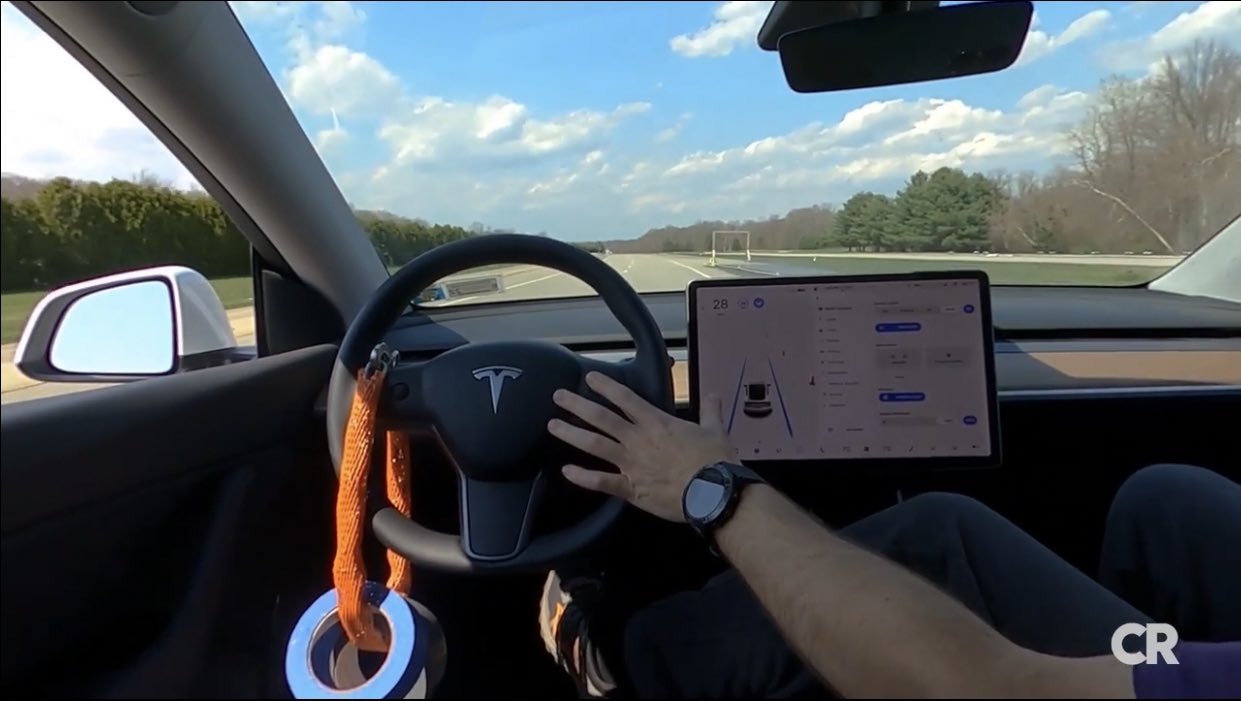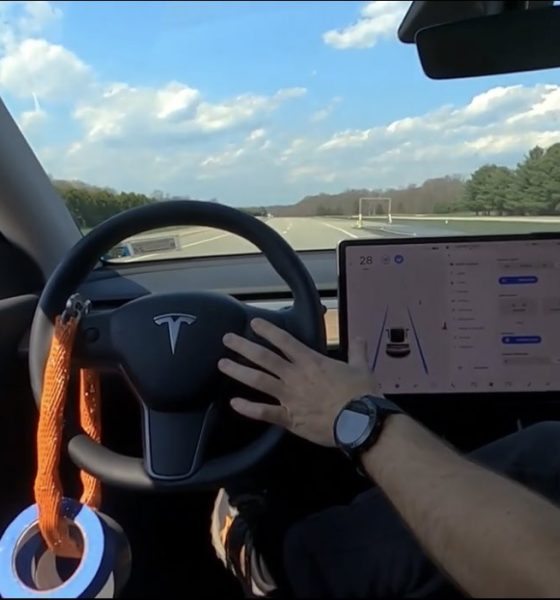

News
Tesla has a misinformation problem, and silence may no longer be enough
During the first quarter earnings call, Lars Moravy, Tesla’s vice president of vehicle engineering, stated that the company is hard at work cooperating with local authorities and agencies like the NTSB and the NHTSA to investigate a fatal Model S crash in Texas earlier this month. Moravy’s statements provided some new insights into the ongoing investigation, particularly when he mentioned that Tesla did a study to see how the company’s technologies operate in the area of the accident.
“We did a study with them over the past week to understand what happened in that particular crash. And what we’ve learned from that effort was that Autosteer did not and could not engage on the road condition that — as it was designed. Our adaptive cruise control only engages when a driver was buckled in about 5 miles per hour. And it only accelerated to 30 miles per hour with the distance before the car crashed,” he said.
A look at Moravy’s statements shows that Tesla’s adaptive cruise control could only accelerate to 30 mph in the distance that the ill-fated Model S covered before it smashed into a tree. This goes against initial reports stating that the vehicle had been involved in a high-speed crash. The state of the Model S when authorities found it also hinted that the car collided with the tree at speeds beyond 30 mph. Moravy’s statement was clear enough, but apparently, it was not clear enough for some — and it’s causing even US congressmen to become misinformed about the issue.
Despite early claims by #Tesla #ElonMusk, autopilot WAS engaged in tragic crash in The Woodlands.
We need answers. https://t.co/e3TQTRv72Z
— Kevin Brady (@RepKevinBrady) April 28, 2021
Misreporting Spreads Quickly
Rep. Kevin Brady recently shared an article on his Twitter page which featured Moravy’s statement from the Q1 earnings call. The only problem was that the article Brady shared misunderstood the Tesla executive’s statement, with the article alleging that “at least one Tesla Autopilot feature was active” during the fatal Tesla crash. This, of course, is completely inaccurate, and EV owners and Tesla Twitter pointed it out as such. Moravy, after all, was referring to a test that the company ran, not the findings of the investigation, which is still ongoing.
Unfortunately, the US congressman seemed unconvinced. Despite the wave of corrections from the EV community and Tesla owners, or just Twitter users who actually bothered to listen and read the Q1 earnings call transcript, Brady argued in a later tweet that the source of his information was Tesla itself. And this, in a lot of ways, brings up a can of worms for the electric car maker and its longtime supporters.
Uh…Tesla. (Read the article, Sparky)
— Kevin Brady (@RepKevinBrady) April 28, 2021
Misinformation must be corrected
This is not the first time that Tesla has found itself on the receiving end of inaccurate reporting. Tesla has always battled misinformation since its early days, from reports claiming that the Model S was vaporware to ones claiming that Giga Shanghai was just an empty shell where Model 3s from Fremont were being stored. But while most of the misreporting surrounding Tesla is now expected by those following the company, and while some of this misinformation is almost humorous — such as a usually-critical Tesla reporter arguing that the Powerwall does not exist because she has never seen one in person — some stories require a more active hand.
Granted, Elon Musk has made his stance clear on advertising, or, as the CEO noted on Twitter, “manipulating public opinion.” However, it is not too difficult to see that Tesla will be fighting an unnecessarily uphill battle against misinformation if it does not have a way to make the correct information public. Musk has also stated on Twitter that “I trust the people,” which is no surprise considering his optimism. However, people are also very easy to manipulate, especially if they are immersed, for the most part, in misinformation.
Other companies spend money on advertising & manipulating public opinion, Tesla focuses on the product.
I trust the people.
— Elon Musk (@elonmusk) April 27, 2021
Not-a-PR Team
If there is anything that the ongoing misinformation surrounding the tragic Texas crash has shown, it is that Tesla may need a better strategy than just staying silent until an inaccurate story dies. This does not have to come in the form of a dedicated PR team or advertisements either, as those are strategies that have worked for companies that are almost antithetical to Tesla. Either way, the EV community may find it advantageous if something could be done about the ongoing inaccurate reports and allegations being thrown against the company. Perhaps Tesla could find a solution that meets these needs while staying true to its out-of-the-box character.
Tesla is a creative company that is unorthodox and bold enough that it decided to build a vehicle assembly line in a sprung structure to meet its goals. With this in mind, there is a pretty good chance that Tesla could find a workaround for its misinformation problem. Before this could happen, of course, Tesla would first have to admit that something more than silence is needed to usher in the company towards new heights.
Don’t hesitate to contact us for news tips. Just send a message to tips@teslarati.com to give us a heads up.

News
Tesla FSD fleet is nearing 7 billion total miles, including 2.5 billion city miles
As can be seen on Tesla’s official FSD webpage, vehicles equipped with the system have now navigated over 6.99 billion miles.

Tesla’s Full Self-Driving (Supervised) fleet is closing in on almost 7 billion total miles driven, as per data posted by the company on its official FSD webpage.
These figures hint at the massive scale of data fueling Tesla’s rapid FSD improvements, which have been quite notable as of late.
FSD mileage milestones
As can be seen on Tesla’s official FSD webpage, vehicles equipped with the system have now navigated over 6.99 billion miles. Tesla owner and avid FSD tester Whole Mars Catalog also shared a screenshot indicating that from the nearly 7 billion miles traveled by the FSD fleet, more than 2.5 billion miles were driven inside cities.
City miles are particularly valuable for complex urban scenarios like unprotected turns, pedestrian interactions, and traffic lights. This is also the difference-maker for FSD, as only complex solutions, such as Waymo’s self-driving taxis, operate similarly on inner-city streets. And even then, incidents such as the San Francisco blackouts have proven challenging for sensor-rich vehicles like Waymos.
Tesla’s data edge
Tesla has a number of advantages in the autonomous vehicle sector, one of which is the size of its fleet and the number of vehicles training FSD on real-world roads. Tesla’s nearly 7 billion FSD miles then allow the company to roll out updates that make its vehicles behave like they are being driven by experienced drivers, even if they are operating on their own.
So notable are Tesla’s improvements to FSD that NVIDIA Director of Robotics Jim Fan, after experiencing FSD v14, noted that the system is the first AI that passes what he described as a “Physical Turing Test.”
“Despite knowing exactly how robot learning works, I still find it magical watching the steering wheel turn by itself. First it feels surreal, next it becomes routine. Then, like the smartphone, taking it away actively hurts. This is how humanity gets rewired and glued to god-like technologies,” Fan wrote in a post on X.
News
Tesla starts showing how FSD will change lives in Europe
Local officials tested the system on narrow country roads and were impressed by FSD’s smooth, human-like driving, with some calling the service a game-changer for everyday life in areas that are far from urban centers.

Tesla has launched Europe’s first public shuttle service using Full Self-Driving (Supervised) in the rural Eifelkreis Bitburg-Prüm region of Germany, demonstrating how the technology can restore independence and mobility for people who struggle with limited transport options.
Local officials tested the system on narrow country roads and were impressed by FSD’s smooth, human-like driving, with some calling the service a game-changer for everyday life in areas that are far from urban centers.
Officials see real impact on rural residents
Arzfeld Mayor Johannes Kuhl and District Administrator Andreas Kruppert personally tested the Tesla shuttle service. This allowed them to see just how well FSD navigated winding lanes and rural roads confidently. Kruppert said, “Autonomous driving sounds like science fiction to many, but we simply see here that it works totally well in rural regions too.” Kuhl, for his part, also noted that FSD “feels like a very experienced driver.”
The pilot complements the area’s “Citizen Bus” program, which provides on-demand rides for elderly residents who can no longer drive themselves. Tesla Europe shared a video of a demonstration of the service, highlighting how FSD gives people their freedom back, even in places where public transport is not as prevalent.
What the Ministry for Economic Affairs and Transport says
Rhineland-Palatinate’s Minister Daniela Schmitt supported the project, praising the collaboration that made this “first of its kind in Europe” possible. As per the ministry, the rural rollout for the service shows FSD’s potential beyond major cities, and it delivers tangible benefits like grocery runs, doctor visits, and social connections for isolated residents.
“Reliable and flexible mobility is especially vital in rural areas. With the launch of a shuttle service using self-driving vehicles (FSD supervised) by Tesla in the Eifelkreis Bitburg-Prüm, an innovative pilot project is now getting underway that complements local community bus services. It is the first project of its kind in Europe.
“The result is a real gain for rural mobility: greater accessibility, more flexibility and tangible benefits for everyday life. A strong signal for innovation, cooperation and future-oriented mobility beyond urban centers,” the ministry wrote in a LinkedIn post.
News
Tesla China quietly posts Robotaxi-related job listing
Tesla China is currently seeking a Low Voltage Electrical Engineer to work on circuit board design for the company’s autonomous vehicles.

Tesla has posted a new job listing in Shanghai explicitly tied to its Robotaxi program, fueling speculation that the company is preparing to launch its dedicated autonomous ride-hailing service in China.
As noted in the listing, Tesla China is currently seeking a Low Voltage Electrical Engineer to work on circuit board design for the company’s autonomous vehicles.
Robotaxi-specific role
The listing, which was shared on social media platform X by industry watcher @tslaming, suggested that Tesla China is looking to fill the role urgently. The job listing itself specifically mentions that the person hired for the role will be working on the Low Voltage Hardware team, which would design the circuit boards that would serve as the nervous system of the Robotaxi.
Key tasks for the role, as indicated in the job listing, include collaboration with PCB layout, firmware, mechanical, program management, and validation teams, among other responsibilities. The role is based in Shanghai.
China Robotaxi launch
China represents a massive potential market for robotaxis, with its dense urban centers and supportive policies in select cities. Tesla has limited permission to roll out FSD in the country, though despite this, its vehicles have been hailed as among the best in the market when it comes to autonomous features. So far, at least, it appears that China supports Tesla’s FSD and Robotaxi rollout.
This was hinted at in November, when Tesla brought the Cybercab to the 8th China International Import Expo (CIIE) in Shanghai, marking the first time that the autonomous two-seater was brought to the Asia-Pacific region. The vehicle, despite not having a release date in China, received a significant amount of interest among the event’s attendees.








